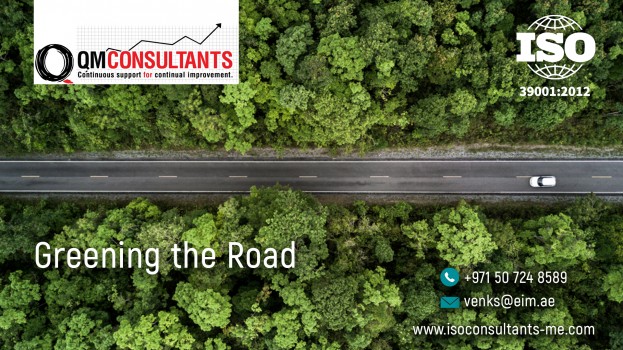
In a world increasingly fixated on sustainability, the intersection of road safety management and environmental consciousness presents a unique opportunity for companies with large vehicle fleets. This blog explores the symbiotic relationship between IS39001:2012, the Road Traffic Safety Management System (RTSMS), carbon emissions reduction, and the Environmental Management System (EMS). As an expert in both carbon emissions and biofuels, we'll delve deep into the ways in which embracing RTSMS can be a pivotal strategy for companies committed to sustainability.
Companies that see ESG reporting as an important cornerstone of their corporate responsibility and have a large fleet of vehicles know very well about their carbon footprints and how it impacts their ESG reporting. This is because a large fleet means a huge consumption of biofuels. These companies can combine their EMS with RTSMS to create an integrated approach.
Just imagine this scenario:
"A large trucking company has more than 500 trucks that carry goods from KSA to UAE and back. The drivers of this company have no knowledge of either environment or road safety. This means wastage of fuels due to rash and erratic driving, constant breakdowns, and of course accidents. Any vehicle accident or breakdown means direct environmental impact. And, if every such impact/ incident is extrapolated on the entire fleet, it results in significant risks to the company's reputation, environmental impacts, generation of waste, and weak governance.
The Overlapping Goals:
Reducing Accidents, Reducing Emissions: A well-implemented RTSMS inherently promotes safer driving practices, leading to fewer accidents. Beyond saving lives, this reduction in accidents translates directly to a decrease in emissions resulting from vehicle crashes, a significant yet often overlooked contributor to environmental impact. Vehicle accidents mean debris, consumption of asbestos-laced greasing, traffic congestion, traffic snarl, and much more. It is estimated that traffic jams caused by accidents on roads result in billions of dollars’ worth of fuel wastage.
Operational Efficiency and Emission Reduction: The optimization of routes, vehicle maintenance, and driver behavior integral to RTSMS not only enhances road safety but also directly impacts fuel efficiency, subsequently reducing carbon emissions.
Compliance with Environmental Regulations: Many countries are introducing regulations that penalize companies for excessive emissions. Implementing RTSMS not only ensures compliance with road safety standards but also positions the company to meet evolving environmental regulations.
Useful Data for Clarity:
Global Accident Statistics: According to the World Health Organization (WHO), road traffic accidents result in approximately 1.35 million deaths annually, contributing significantly to environmental burdens through vehicle emissions and emergency response activities.
Emissions from Accidents: The U.S. Federal Highway Administration estimates that emissions from traffic congestion due to accidents can increase by 10% to 50%, depending on the severity of the incident.
Fuel Efficiency Impact: The U.S. Environmental Protection Agency (EPA) states that aggressive driving behaviors, which ISO 39001:2012 aims to mitigate, can lower gas mileage by roughly 15% to 30% at highway speeds and 10% to 40% in stop-and-go traffic.
The Synergy Between Systems:
Comprehensive Sustainability Strategy: RTSMS and EMS are complementary frameworks. While RTSMS focuses on road safety and operational efficiency, EMS addresses the broader environmental impact of an organization's activities, including energy use, waste management, and emissions reduction. Proper implementation of RTSMS also leads to better vehicle efficiency, fuel efficiency, and resource management; goals similar to EMS.
ISO Standards Harmony: Aligning RTSMS with ISO39001:2012 and EMS with ISO14001 establishes a harmonized approach to sustainability. This integration ensures that the company is not only safe on the roads but also environmentally responsible.
Continuous Improvement: Both systems emphasize a cycle of continuous improvement. By weaving RTSMS into the fabric of EMS, organizations can create a holistic approach that continually optimizes both safety and environmental performance.
Biofuels as a Green Alternative:
Reduced Carbon Footprint: Biofuels, derived from renewable sources like plant materials, agricultural residues, or waste, have the potential to significantly reduce the carbon footprint of a fleet when compared to traditional fossil fuels.
Compatibility with Existing Vehicles: Many biofuels can be used in existing vehicle fleets with minimal modifications, providing a practical and immediate solution for companies looking to transition to greener fuel alternatives.
Government Incentives: Governments worldwide are increasingly providing incentives for companies adopting biofuels, ranging from tax credits to subsidies. Integrating biofuels into fleet management aligns with sustainability goals and often leads to financial benefits.
Conclusion:
Embracing Road Traffic Safety Management Systems is not merely a commitment to safer roads; it is a strategic move toward a sustainable future. By intertwining RTSMS with a robust Environmental Management System and incorporating eco-friendly practices such as the adoption of biofuels, companies with large vehicle fleets can achieve operational excellence while significantly reducing their environmental impact.
The journey to sustainability starts with every mile traveled. Let your commitment to road safety be the driving force for a greener tomorrow.
Comment Section
Existing Comments: